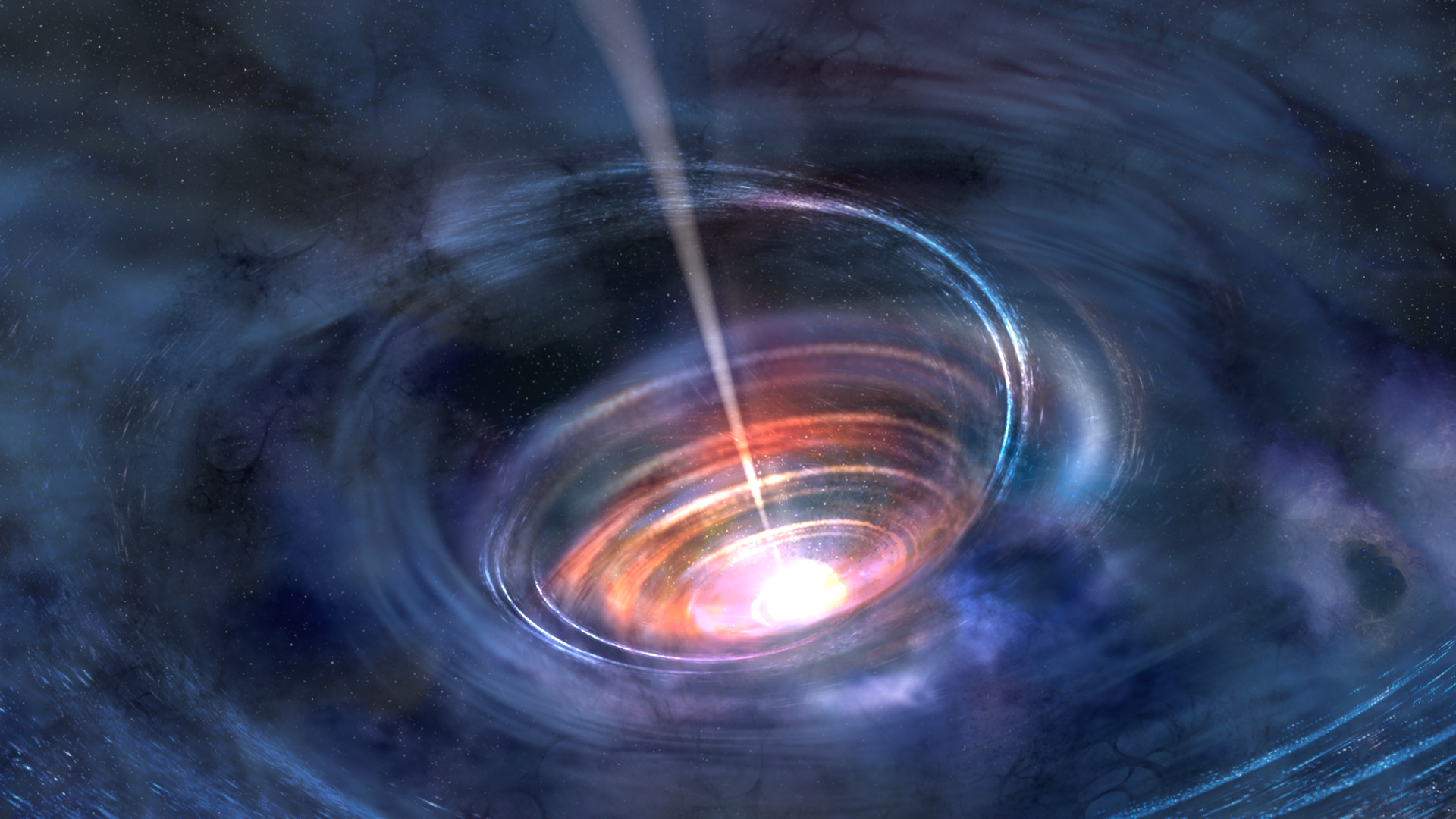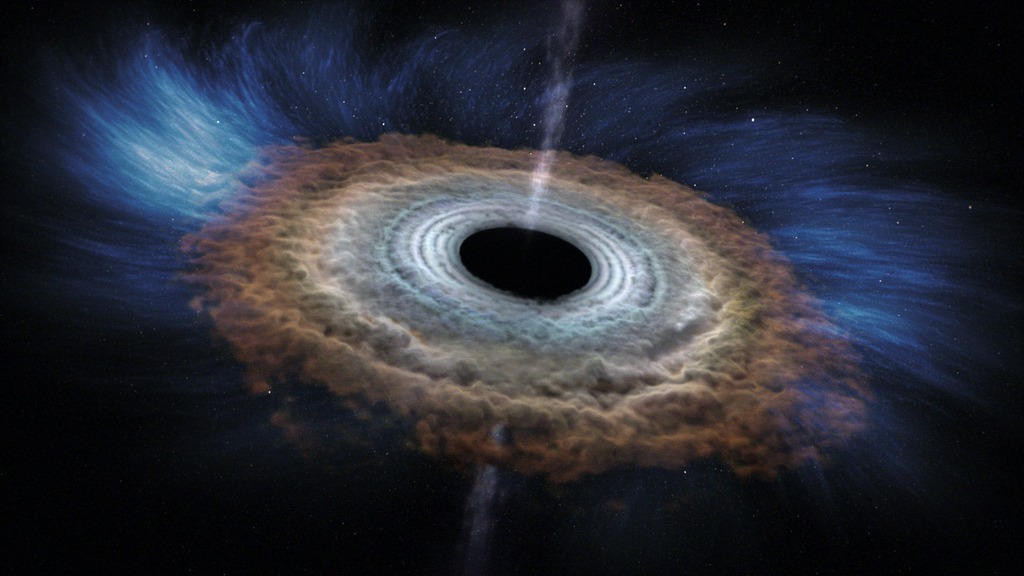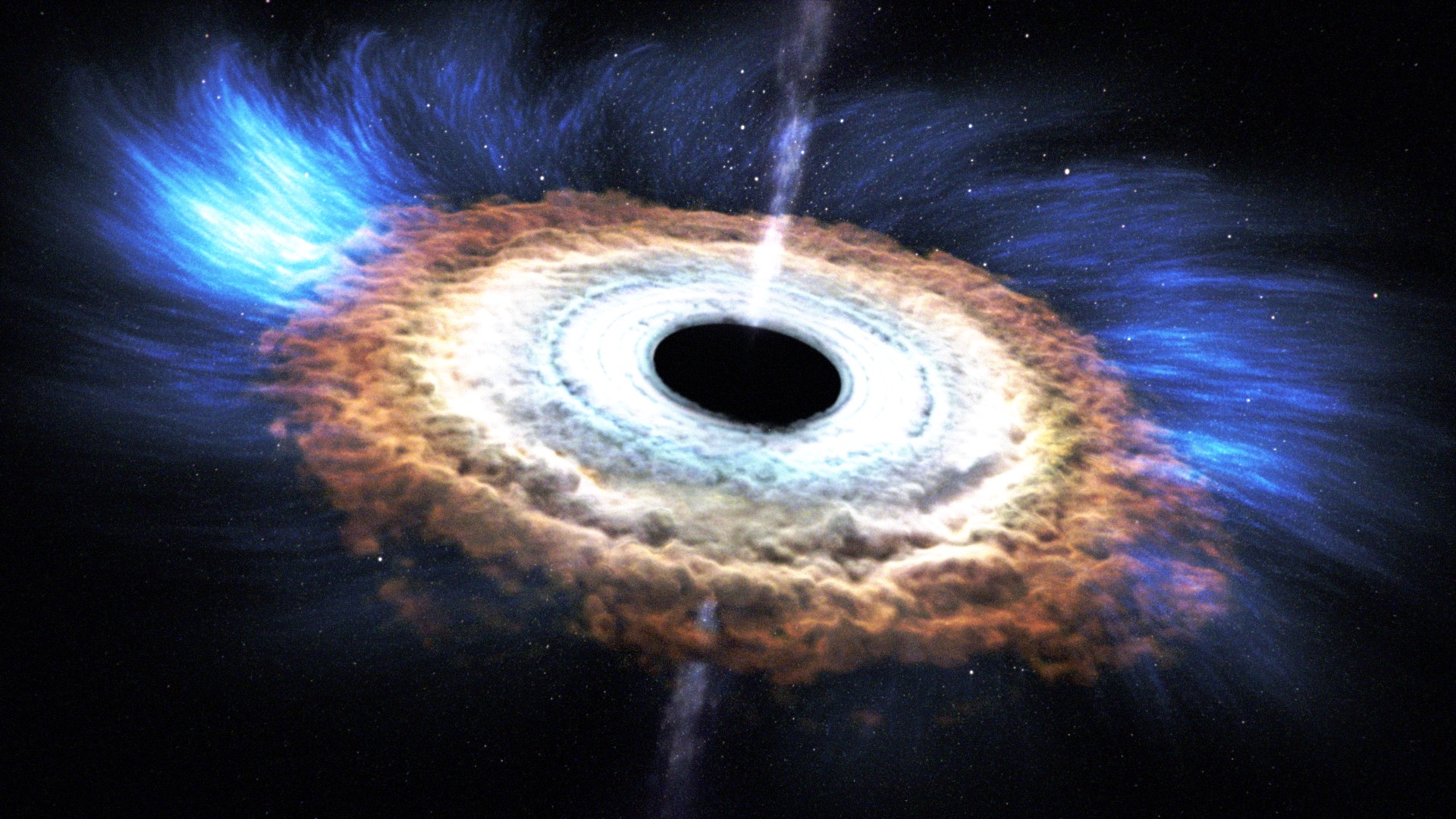NASA's Swift Satellite Spots Black Hole Devouring A Star
In late March 2011, NASA's Swift satellite alerted astronomers to intense and unusual high-energy flares from a new source in the constellation Draco. They soon realized that the source, which is now known as Swift J1644+57, was the result of a truly extraordinary event — the awakening of a distant galaxy's dormant black hole as it shredded and consumed a star. The galaxy is so far away that the radiation from the blast has traveled 3.9 billion years before reaching Earth.
Most galaxies, including our own, possess a central supersized black hole weighing millions of times the sun's mass. According to the new studies, the black hole in the galaxy hosting Swift J1644+57 may be twice the mass of the four-million-solar-mass black hole lurking at the center of our own Milky Way galaxy. As a star falls toward a black hole, it is ripped apart by intense tides. The gas is corralled into a disk that swirls around the black hole and becomes rapidly heated to temperatures of millions of degrees.
The innermost gas in the disk spirals toward the black hole, where rapid motion and magnetism creates dual, oppositely directed "funnels" through which some particles may escape. Particle jets driving matter at velocities greater than 80-90 percent the speed of light form along the black hole's spin axis. In the case of Swift J1644+57, one of these jets happened to point straight at Earth.
Theoretical studies of tidally disrupted stars suggested that they would appear as flares at optical and ultraviolet energies. The brightness and energy of a black hole's jet is greatly enhanced when viewed head-on. The phenomenon, called relativistic beaming, explains why Swift J1644+57 was seen at X-ray energies and appeared so strikingly luminous.
When first detected on March 28, the flares were initially assumed to signal a gamma-ray burst, one of the nearly daily short blasts of high-energy radiation often associated with the death of a massive star and the birth of a black hole in the distant universe. But as the emission continued to brighten and flare, astronomers realized that the most plausible explanation was the tidal disruption of a sun-like star seen as beamed emission.
On March 28, 2011, NASA's Swift detected intense X-ray flares thought to be caused by a black hole devouring a star. In one model, illustrated here, a sun-like star on an eccentric orbit plunges too close to its galaxy's central black hole. About half of the star's mass feeds an accretion disk around the black hole, which in turn powers a particle jet that beams radiation toward Earth.
Credit: NASA/Goddard Space Flight Center/CI Lab

This illustration steps through the events that scientists think likely resulted in Swift J1644+57.
Credit: NASA/Goddard Space Flight Center/Swift

This illustration steps through the events that scientists think likely resulted in Swift J1644+57. No Labels.
Credit: NASA/Goddard Space Flight Center/Swift

Swift's X-Ray Telescope continues to record high-energy flares from Swift J1644+57 more than three months after the source's first appearance. Astronomers believe that this behavior represents the slow depletion of gas in an accretion disk around a supermassive black hole. The first flares from the source likely coincided with the disk's creation, thought to have occurred when a star wandering too close to the black hole was torn apart.
Credit: NASA/Swift/Penn State

Swift's X-Ray Telescope continues to record high-energy flares from Swift J1644+57 more than three months after the source's first appearance. Astronomers believe that this behavior represents the slow depletion of gas in an accretion disk around a supermassive black hole. The first flares from the source likely coincided with the disk's creation, thought to have occurred when a star wandering too close to the black hole was torn apart. No Labels.
Credit: NASA/Swift/Penn State

Positions from Swift's XRT constrained the source to a small patch of sky that contains a faint galaxy known to be 3.9 billion light-years away. But to link the Swift event to the galaxy required observations at radio wavelengths, which showed that the galaxy's center contained a brightening radio source. Analysis of that source using the Expanded Very Large Array and Very Long Baseline Interferometry (VLBI) shows that it is still expanding at more than half the speed of light.
Credit: NRAO/CfA/Zauderer et al.

Positions from Swift's XRT constrained the source to a small patch of sky that contains a faint galaxy known to be 3.9 billion light-years away. But to link the Swift event to the galaxy required observations at radio wavelengths, which showed that the galaxy's center contained a brightening radio source. Analysis of that source using the Expanded Very Large Array and Very Long Baseline Interferometry (VLBI) shows that it is still expanding at more than half the speed of light. No Labels.
Credit: NRAO/CfA/Zauderer et al.

Images from Swift's Ultraviolet/Optical (white, purple) and X-Ray telescopes (yellow and red) were combined to make this view of Swift J1644+57. Evidence of the flares is seen only in the X-ray image, which is a 3.4-hour exposure taken on March 28, 2011.
Credit: NASA/Swift/Stefan Immler

Images from Swift's Ultraviolet/Optical (white, purple) and X-Ray telescopes (yellow and red) were combined to make this view of Swift J1644+57. Evidence of the flares is seen only in the X-ray image, which is a 3.4-hour exposure taken on March 28, 2011. No Labels.
Credit: NASA/Swift/Stefan Immler

Still from animation

Still from animation.

This illustration highlights the principal features of Swift J1644+57 and summarizes what astronomers have discovered about it. (There are two versions of the image here. One with labels and one without labels.) Credit: NASA's Goddard Space Flight Center
For More Information
Credits
Please give credit for this item to:
NASA/Goddard Space Flight Center. However, each element should be credited as indicated above.
-
Animator
- Ryan Zuber (UMBC)
-
Producer
- Scott Wiessinger (UMBC)
-
Science writer
- Francis Reddy (University of Maryland College Park)
-
Graphics
- Francis Reddy (University of Maryland College Park)
Missions
This page is related to the following missions:Series
This page can be found in the following series:Tapes
The media on this page originally appeared on the following tapes:-
Various Small Astrophysics projects
(ID: 2010139)
Friday, December 17, 2010 at 5:00AM
Produced by - Robert Crippen (NASA)
Datasets used
-
[Swift]
ID: 217
Note: While we identify the data sets used on this page, we do not store any further details, nor the data sets themselves on our site.
Release date
This page was originally published on Wednesday, August 24, 2011.
This page was last updated on Wednesday, May 3, 2023 at 1:53 PM EDT.



